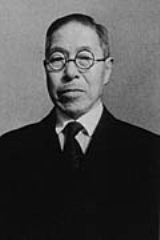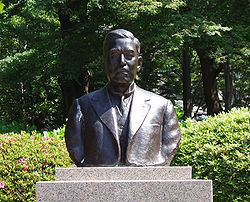
Kiyoshi Shiga
Encyclopedia

was a Japan
Japan
Japan is an island nation in East Asia. Located in the Pacific Ocean, it lies to the east of the Sea of Japan, China, North Korea, South Korea and Russia, stretching from the Sea of Okhotsk in the north to the East China Sea and Taiwan in the south...
ese physician
Physician
A physician is a health care provider who practices the profession of medicine, which is concerned with promoting, maintaining or restoring human health through the study, diagnosis, and treatment of disease, injury and other physical and mental impairments...
and bacteriologist
Bacteriology
Bacteriology is the study of bacteria. This subdivision of microbiology involves the identification, classification, and characterization of bacterial species...
.
Biography
Shiga was born in Sendai, Miyagi PrefectureMiyagi Prefecture
is a prefecture of Japan in the Tōhoku Region on Honshu island. The capital is Sendai.- History :Miyagi Prefecture was formerly part of the province of Mutsu. Mutsu Province, on northern Honshu, was one of the last provinces to be formed as land was taken from the indigenous Emishi, and became the...
, though his original family name was Satō. He graduated from the Medical School of Tokyo Imperial University
University of Tokyo
, abbreviated as , is a major research university located in Tokyo, Japan. The University has 10 faculties with a total of around 30,000 students, 2,100 of whom are foreign. Its five campuses are in Hongō, Komaba, Kashiwa, Shirokane and Nakano. It is considered to be the most prestigious university...
in 1896 and went to work at the Institute for the Study of Infectious Diseases under Dr. Kitasato Shibasaburō
Kitasato Shibasaburō
Baron was a Japanese physician and bacteriologist. He is remembered as the co-discoverer of the infectious agent of bubonic plague in Hong Kong in 1894, almost simultaneously with Alexandre Yersin.-Biography:...
. Shiga became famous for the discovery of Shigella dysenteriae
Shigella dysenteriae
Shigella dysenteriae is a species of the rod-shaped bacterial genus Shigella. Shigella can cause shigellosis . Shigellae are Gram-negative, non-spore-forming, facultatively anaerobic, non-motile bacteria.S...
, the bacillus causing dysentery
Dysentery
Dysentery is an inflammatory disorder of the intestine, especially of the colon, that results in severe diarrhea containing mucus and/or blood in the faeces with fever and abdominal pain. If left untreated, dysentery can be fatal.There are differences between dysentery and normal bloody diarrhoea...
, in 1897, during a severe epidemic in which more than 90,000 cases were reported, with a mortality rate approaching 30%. The bacterium Shigella was thus named after him, as well as the shiga toxin
Shiga toxin
Shiga toxins are a family of related toxins with two major groups, Stx1 and Stx2, whose genes are considered to be part of the genome of lambdoid prophages. The toxins are named for Kiyoshi Shiga, who first described the bacterial origin of dysentery caused by Shigella dysenteriae. The most common...
, which is produced by the bacterium.
After the discovery of Shigella, Shiga worked with Paul Ehrlich
Paul Ehrlich
Paul Ehrlich was a German scientist in the fields of hematology, immunology, and chemotherapy, and Nobel laureate. He is noted for curing syphilis and for his research in autoimmunity, calling it "horror autotoxicus"...
in Germany
Germany
Germany , officially the Federal Republic of Germany , is a federal parliamentary republic in Europe. The country consists of 16 states while the capital and largest city is Berlin. Germany covers an area of 357,021 km2 and has a largely temperate seasonal climate...
from 1901 to 1905. After returning to Japan, he resumed the study of infectious diseases with Dr. Kitasato. He became a professor at Keio University
Keio University
,abbreviated as Keio or Keidai , is a Japanese university located in Minato, Tokyo. It is known as the oldest institute of higher education in Japan. Founder Fukuzawa Yukichi originally established it as a school for Western studies in 1858 in Edo . It has eleven campuses in Tokyo and Kanagawa...
in 1920.
From 1929-31, Shiga was the president of Keijō Imperial University
Keijo Imperial University
was a Japanese Imperial University that existed in Seoul between 1924 and the end of World War II.-History:...
in Keijo (Seoul)
Seoul
Seoul , officially the Seoul Special City, is the capital and largest metropolis of South Korea. A megacity with a population of over 10 million, it is the largest city proper in the OECD developed world...
and was senior medical advisor to the Japanese Governor-General of Korea. Shiga was a recipient of the Order of Culture
Order of Culture
The is a Japanese order, established on February 11, 1937. The order has one class only, and may be awarded to men and women for contributions to Japan's art, literature or culture; recipients of the order also receive an annuity for life...
in 1944. He was also awarded the Order of the Sacred Treasure
Order of the Sacred Treasure
The is a Japanese Order, established on January 4, 1888 by Emperor Meiji of Japan as the Order of Meiji. It is awarded in eight classes . It is generally awarded for long and/or meritorious service and considered to be the lowest of the Japanese orders of merit...
, 1st class, on his death in 1957.

